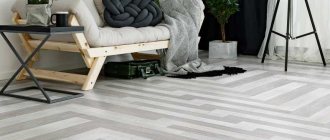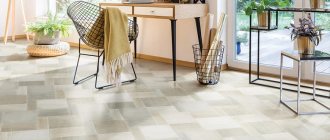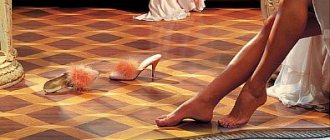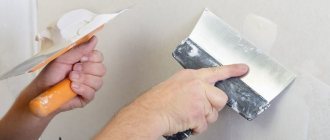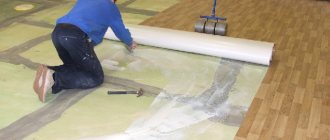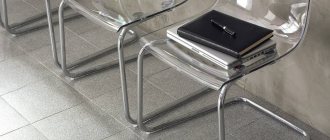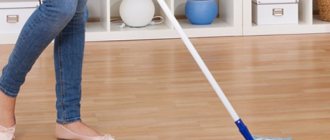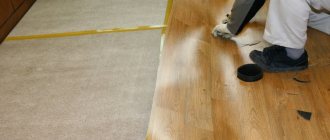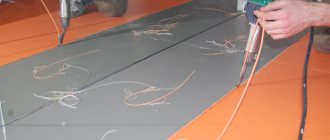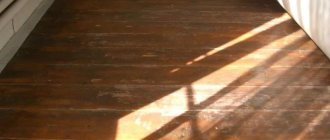In the modern flooring market, consumers most often prefer linoleum. However, when choosing, you must keep in mind that there are a huge number of varieties, each of which has individual characteristics, which means the quality can vary significantly. One of the most popular types, due to its relatively low cost and excellent performance properties, is polyvinyl chloride linoleum, better known as PVC.
Types of linoleum
Linoleum is distinguished by material, base and area of application. We will review each type to help you choose the right floor covering.
By material
The flooring product is made from various synthetic and natural materials. This allows you to select and lay linoleum that suits the conditions in a particular room.
Natural material
Linoleum made from natural material is environmentally friendly. It has antistatic and wear-resistant properties. Resistant to fire, fats and various reagents. You won't be able to choose a color to match the interior. Coatings made from natural ingredients are produced in one color.
The composition includes the following components:
- pine tree resin,
- flax oil,
- lime powder,
- wood flour,
- natural dyes.
Important! High humidity is contraindicated for a natural product. It should not be bent because it breaks easily.
PVC
Polyvinyl chloride (PVC) flooring is made from polyvinyl chloride with the addition of various dyes. PVC products can be homogeneous or heterogeneous.
Homogeneous PVC linoleum contains one layer, which includes a base, a backing and a protective layer. Heterogeneous is a multilayer coating. It consists of a base, middle, strengthening and top layers. Each layer is fixed with PVC paste.
PVC material has the following advantages:
- Resistant to moisture, wear, and fading.
- Available in a varied color palette.
- It has an optimal price category.
Among the disadvantages of PVC linoleum is a slight smell of synthetic components, which disappears after a few days. And also the high fire hazard of the floor product.
Colloxylin
This material is used in places with high humidity. It contains nitrocellulose, dyes, and mineral additives. Such flooring products have good flexibility and a wide range of colors. At the same time, they are very thin to the touch and do not have a base. Disadvantages: rapid flammability, low frost resistance.
Important! Colloxylin floor covering is allowed to be used only in industrial premises.
Alkyd
An alkyd product consists of alkyd resin, additives and pigments. The composition is applied to a fabric base. Linoleum has good sound and heat insulation qualities and high wear resistance. Used in warehouses and offices.
Disadvantages of alkyd material:
- at low temperatures, shrinkage and cracking occur;
- lack of elasticity;
- is fire hazardous and releases toxic substances when burned.
Relin
Relin or rubber linoleum consists of two layers. The bottom layer is made of crushed rubber or bitumen. The top layer is rubber with various additives. This layer is made in relief to reduce the sliding properties of the surface. This coating is elastic, moisture-resistant, frost-resistant, and durable. Relin is used in public places: elevators, airports, hospitals, train stations.
Based on
The base of linoleum is the lowest layer that meets the floor. Thermal and sound insulation, strength, and service life of the product depend on the base. The base helps hide uneven floors.
Linoleum without base
Material without base – thin floor covering no more than 2 mm thick. This product does not have heat or sound insulating properties. Can tear quickly on uneven floors. It can only be laid on a perfectly flat heated floor or chipboard. The advantage of baseless linoleum is its general availability.
Foam base
Foamed PVC base is most convenient to use. Coating thickness – 1.5 – 3.5 mm. You can lay such material in any room. The foam base has the following advantages:
- moisture resistance - ideal in the bathroom, kitchen, hallway;
- resistance to mechanical loads, punching - quickly restores its original appearance;
- long service life - an average of 10 years.
High temperatures are harmful to the PVC base. It loses all its positive properties at temperatures above 26 ℃. Therefore, this product is not used on heated floors.
Felt base
Linoleum on a felt or fabric basis is the thickest and most environmentally friendly. Its thickness is on average 5 mm. It has good sound and heat insulation. Suitable for dry, warm rooms with uneven floors. In this case, the material shrinks slightly. And is not able to recover from various pressures.
Today, the felt base is impregnated with special compounds. They help fight felt rotting. Still, you should refrain from using felt-based products in cold and damp rooms.
By area of application
The area of application of flooring is divided into several types. This is determined by the purpose of the place where the material will be used.
Domestic
Household linoleum is used to cover floors in apartments and houses. It consists of several layers. It can be baseless or on a foamed PVC base. The thickness of the protective layer is up to 0.35 mm. This material is easy to care for. It comes in a variety of colors and low prices.
In domestic premises, the second class of linoleum is used. It has the following classification:
- 21 – used in places with low mechanical load – bedrooms, storage rooms, dressing rooms;
- 22 – used in places with average mechanical load – children’s rooms, living rooms;
- 23 - used in places with high mechanical load - corridors, kitchens, halls.
Semi-commercial
Semi-commercial coverings are laid in public spaces, offices, and homes. The structure of a semi-commercial flooring product is similar to a household one. But it has a thicker protective layer of up to 0.7 mm, which increases its wear resistance.
In semi-commercial premises, the third class of linoleum is used. It has the following classification:
- 31 – used for public places with low mechanical load – hotel rooms, boss’s office;
- 32 - used for places with medium mechanical load - school classrooms, preschool institutions, medical institutions;
- 33 - used for places with high mechanical load - school corridors, large offices;
- 34 - used for places with increased mechanical load - shopping centers, train stations, cinemas.
Commercial
Commercial flooring is characterized by a long service life, high wear resistance, and non-flammability. This material is not afraid of various pressures from shoes, furniture legs and equipment. The protective layer has a thickness of 0.6 mm.
In commercial premises, the fourth class of product is used. It has the following classification:
- 41 – used for public places with low mechanical load – sewing workshop, electrical equipment repair shop;
- 42 - used for places with medium mechanical load, where work is performed standing, and equipment is occasionally used - warehouse, repair area;
- 43 - used for places with high mechanical load, where special equipment is used and high traffic intensity - large industrial areas.
Special
Floor coverings made for specific purposes are called special. Special linoleum can have the following varieties.
- Sports. Polyurethane is used as a protective layer. It increases the product's resistance to wear and contamination. The bottom layer is made of foamed PVC. This allows you to soften the impact of a fall and increase the elasticity of the coating.
- Antibacterial. The protective layer has antimicrobial properties. This material is used in laboratories, kindergartens, and medical institutions.
- Antistatic. The material obtains such properties by adding graphite to its composition. The area of application of the coating is rooms with electronic equipment, server rooms.
- Stage. Has a matte top layer. This makes it possible to obtain the necessary light balance on stage. The material contains PVC, surface additives that impart plasticity, and various dyes. These products are also used in ballet and dance classes.
- Wall. It is used to seal walls in hospitals in the food and pharmaceutical industries. The wall covering is resistant to various damages.
- Anti-slip. The floor covering contains special additives in the surface layer: quartz chips, metal granules. A non-slip surface is also obtained due to the relief of the top layer. This material is used in places where various liquids may get on the floor. These are kitchens, swimming pools, cafes, shops.
Fire safety class
Another class inherent in linoleum is the fire safety class.
. This is a complex indicator that determines the resistance of a material to fire according to several criteria. The most resistant coatings have class KM0 (“ka em zero”). Linoleum with class KM2 is suitable for use in commercial premises. For home use, KM5 coating is sufficient. Indeed, such linoleum received lower ratings in all respects compared to KM2, but it does not have the task of holding out until hundreds of people safely leave the building. Therefore, if you choose linoleum for an apartment or private house, you don’t have to rely on the fire safety class. But if you are doing repairs in a school, office, or medical facility, choose only from the KM2 options (on our website, for example, you can use the filter of the same name).
| Criteria for evaluation | Fire hazard class of building materials depending on groups | |||||
| KM0 | KM1 | KM2 | KM3 | KM4 | KM5 | |
| Flammability | NG | G1 | G1 | G2 | G2 | G4 |
| Flammability | — | IN 1 | IN 1 | AT 2 | AT 2 | AT 3 |
| Smoke formation | — | D1 | D3+ | D3 | D3 | D3 |
| Toxicity of combustion products | — | T1 | T2 | T2 | T3 | T4 |
| Flame spread over surface | — | RP1 | RP1 | RP1 | RP2 | RP4 |
Important points before purchasing
Before you buy linoleum, you need to pay attention to several important points. Let's look at them.
Width and length
Measure the width and length of the room at several points in the room, hallway or kitchen. Select the highest result. To the initial data, add approximately 10 cm for uneven walls, recesses, protrusions, and for connecting the pattern. Be sure to measure the doorway so you don’t have to deal with joining the pieces later.
It is advisable to buy a piece of linoleum according to the width of the room. This way you will avoid unnecessary seams and joints. Today, manufacturers offer flooring widths from 1.5 m to 5 m. Therefore, you can easily find a suitable piece of the required size.
Pattern and color
Look at the drawing. It must be clear. An indicator of quality is also the uniform placement of the print over the entire surface of the material. It is advisable to buy pieces of the required sizes from one roll to avoid differences in tone.
It is important to consider the color layer so that it harmonizes with the rest of the room's shades. A cover with a small print is suitable for a small room. A product with an abstract image will transform a large room. A bright, cheerful pattern is most suitable for a children's room.
Smell
As strange as it may sound, smell the linoleum. A sharp, unpleasant odor will indicate a poor-quality coating composition. You should refuse to purchase such material. A good quality product smells practically nothing, even from synthetic components.
Abrasion
Check the markings of the selected coating for abrasion. This indicator will tell you how quickly the top protective layer of the product will be erased. In accordance with the standard, 4 types of abrasion are distinguished.
- High abrasion. Indicated by the letter F. The flooring material is made from cheap components. The wear of the protective layer reaches a thickness of 0.6 mm.
- Average abrasion. Indicated by the letter M. The flooring product is made of higher quality components than the material with the letter F. The wear of the protective layer reaches a thickness of 0.3 mm.
- Low abrasion. Indicated by the letter P. The floor covering is made of durable materials. The wear of the protective layer reaches a thickness of 0.15 mm.
- Abrasion tends to zero. Indicated by the letter T. The flooring product is made of high-strength components. The wear of the protective layer reaches a thickness of 0.08 mm.
Adviсe
It is recommended to purchase flooring in specialized stores. There you can ask the seller for a hygiene certificate for the material. This certificate shows that the linoleum has been tested and meets safety standards.
When rolled out, high-quality material has a flat, smooth surface and does not have peeling of the top layer. The cut piece of covering should be wrapped with the pattern inside. It should not be bent. Otherwise, there will be a trace of the crease that will not be restored.
Unroll the roll in the room where you will improve the floor surface. It is advisable to let the unfolded piece rest for a day. In a day, the floor product will be completely leveled, then you can begin laying it, trimming it, and securing it.
Thickness
The thickness of linoleum varies from 1.8 mm to 6.5 mm. It is quite logical that thin linoleums are cheaper and belong to a lower wear resistance class (except for calender linoleum, which will be discussed below), while the thickest ones - sports coatings - are comparable in cost per square to parquet boards. Among household coatings, 3 mm linoleum is the most reliable. An even more durable option is reinforced household linoleum.
or
semi-commercial
.
They also gradually increase in thickness and protective layer. The choice of linoleum thickness is a purely individual matter and depends on the circumstances. If you are making temporary repairs, then you can get by with cheap linoleum
. If you want to solve the problem with the floor for a long time, look at options with a good wear resistance class. An important criterion is the drawing. Sometimes you have to sacrifice thickness (or pay a little more money) because of a design you like.
Decorative properties
The color palette and floor pattern significantly changes the perception of the entire interior. That is why the choice of colors must be approached thoroughly. In small rooms, a light background is more suitable , because... it visually expands the space. Warm colors create coziness. The unobtrusive design has a calming effect on a person, and bright colors add energy and emotion. A dark background can cause depression.
Experts recommend taking such nuances into account. Gloss is undesirable on the floor , because... quickly fades, reducing attractiveness. The distance between the elements of the ornament must be at least 10-12 mm, otherwise they may cause ripples in the eyes.
Useful videos
Look at useful tips on choosing linoleum: How to decide on the choice of linoleum, how not to make a mistake in the huge assortment, how not to get confused in its properties and characteristics, see: How to choose flooring for each room in the house: Calculation of linoleum for a room and an apartment - that’s all subtleties and features, how to calculate correctly and not overpay - different calculation options - in linear meters and square footage, look: Is it possible to lay new linoleum on top of the old one - tips and recommendations for installation:
Protective layer thickness
The protective layer is made of PVC or polyurethane (sometimes polyacrylic). The protective layer (as the name suggests) protects the design from abrasion. The higher the load in the room, the thicker the protective layer should be (for industrial premises and sports grounds, commercial homogeneous linoleum is purchased). But you shouldn’t overdo it either - firstly, a thick protective layer makes the product more expensive, and secondly, the thickness of the layers affects the total thickness of the coating, which affects the weight. And the heavy weight creates additional costs, increasing shipping costs and lifting costs (and lifting is often done manually to avoid ruining the cover trying to fit it into the elevator). We recommend, based on the class, to choose coatings suitable for operating conditions.
↑ Advice from experienced craftsmen
- Unlike PVC coatings, natural linoleum is laid strictly in one direction, which is indicated on the reverse side of the canvas.
- Natural linoleum tends to shrink in the longitudinal direction. In this regard, experts recommend rewinding the rolls with the front side inward before laying.
- In the transverse direction, natural linoleum, on the contrary, tends to expand, so it must be cut so that adjacent sheets contact each other with sharp edges. When expanded, the edges of the canvases will touch each other in such a way that a very dense seam will be obtained, almost invisible to the eye.
Natural linoleum is good for everyone! Strong, reliable, durable. And if you choose a floor covering for your home with ideal characteristics, then this will be the covering.
The basis
The base is the bottom layer of linoleum that is in contact with the concrete or wood of the subfloor.
First, let's discuss homogeneous linoleum - it consists of the same material throughout its entire thickness; most often, the base itself is not distinguished. Some collections (for example, Tarkett Melodia) have a compact foam base.
Linoleum with a base can be divided into two groups - with a fabric or felt base and linoleum with a foam base. With the development of production technologies, the difference between these two types of bases is increasingly becoming a matter of taste. In linoleum, presented at relatively affordable prices, both jute and felt will be synthetic. But this has its advantages - synthetic materials are not so afraid of moisture, and if linoleum on a natural jute base should never be used in the kitchen (due to the risk of mold), then linoleum on a TZI base will withstand such a test. In addition, linoleum with a “soft” base will hide minor unevenness and cracks in the subfloor and does not require gluing to the base, which means it will save money and time on installation.
Foam-based linoleum has similar advantages - it is easy to install, provides softness when walking (springs underfoot), holds its shape well, and is not afraid of any level of humidity. But in most cases it requires gluing to the base to ensure the service life declared by the manufacturer.
Both bases - felt and foam - give linoleum high thermal insulation characteristics. Felt due to the creation of an air gap between the base and the coating, foam - due to the overall thickness and structure of the coating. So modern coatings on TZI and felt can be safely classified as insulated linoleum
.
Many manufacturers also apply markings to the base to make it easier to cut the linoleum for the room. In addition, the scope of application, technical features, and method of installation (the need for gluing) are indicated. They also list the key requirements for the base, so that it is dry, even, clean, and durable.

